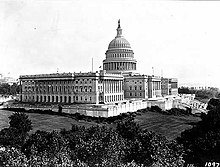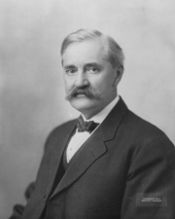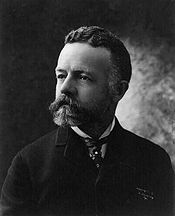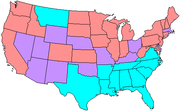67th United States Congress: Difference between revisions
Rescuing 1 sources and tagging 0 as dead. #IABot (v1.2.4) |
|||
| Line 1,444: | Line 1,444: | ||
==External links== |
==External links== |
||
* [http://www.gpoaccess.gov/serialset/cdocuments/hd108-222/index.html Biographical Directory of the U.S. Congress] |
* [https://web.archive.org/web/20060601025644/http://www.gpoaccess.gov/serialset/cdocuments/hd108-222/index.html Biographical Directory of the U.S. Congress] |
||
* [http://clerk.house.gov/art_history/house_history/index.html U.S. House of Representatives: House History] |
* [http://clerk.house.gov/art_history/house_history/index.html U.S. House of Representatives: House History] |
||
* [http://www.senate.gov/pagelayout/reference/two_column_table/stats_and_lists.htm U.S. Senate: Statistics and Lists] |
* [http://www.senate.gov/pagelayout/reference/two_column_table/stats_and_lists.htm U.S. Senate: Statistics and Lists] |
||
Revision as of 09:16, 30 September 2016
| 67th United States Congress | |
|---|---|
66th ← → 68th | |
 United States Capitol (1906) | |
March 4, 1921 – March 4, 1923 | |
| Members | 96 senators 435 representatives 5 non-voting delegates |
| Senate majority | Republican |
| Senate President | Calvin Coolidge (R) |
| House majority | Republican |
| House Speaker | Frederick H. Gillett (R) |
| Sessions | |
| Special: March 4, 1921 – March 15, 1921 1st: April 11, 1921 – November 23, 1921 2nd: December 5, 1921 – September 22, 1922 3rd: November 20, 1922 – December 4, 1922 4th: December 4, 1922 – March 3, 1923 | |


The Sixty-seventh United States Congress was a meeting of the legislative branch of the United States federal government, consisting of the United States Senate and the United States House of Representatives. It met in Washington, D.C. from March 4, 1921 to March 4, 1923, during the first two years of Warren Harding's presidency. The apportionment of seats in the House of Representatives was based on the Thirteenth Census of the United States in 1910. Both chambers had a Republican majority.


Albert B. Cummins

Henry Cabot Lodge
Oscar Underwood
Major events
- March 4, 1921: Warren G. Harding inaugurated as President of the United States
Major Legislation
- May 19, 1921: Emergency Quota Act (Johnson Quota Act), Sess. 1, ch. 8, 42 Stat. 5
- May 27, 1921: Emergency Tariff of 1921, Sess. 1, ch. 14, 42 Stat. 9
- June 10, 1921: Budget and Accounting Act of 1921 (Good-McCormack Act)
- June 10, 1921: Willis Graham Act
- July 2, 1921: Knox–Porter Resolution
- July 9, 1921: Hawaiian Homes Commission Act of 1921
- July 12, 1921: Naval Appropriations Act For 1922
- August 15, 1921: Packers and Stockyards Act of 1921
- August 15, 1921: Poultry Racket Act
- August 24, 1921: Future Trading Act (Capper-Tincher Act), Sess. 1, ch. 86, 42 Stat. 187
- November 9, 1921: Federal Aid Highway Act of 1921 (Phipps-Dowell Act)
- November 23, 1921: Revenue Act of 1921, Sess. 1, ch. 136, 42 Stat. 227
- November 23, 1921: Willis-Campbell Act
- November 23, 1921: Sheppard-Towner Act
- December 22, 1921: Russian Famine Relief Act
- February 9, 1922: World War Foreign Debts Commission Act
- February 18, 1922: Capper-Volstead Act
- February 18, 1922: Patent Act of 1922
- March 4, 1922: Model Marine Insurance Act of 1922
- March 20, 1922: Seed and Grain Loan Act
- March 20, 1922: General Exchange Act of 1922
- May 11, 1922: Agricultural Appropriations Act of 1922
- May 11, 1922: Travelling Expenses Publication Activities Act
- May 15, 1922: Irrigation Districts and Farm Loans Act (Raker Act)
- May 26, 1922: Narcotic Drugs Import and Export Act (Jones-Miller Act)
- June 10, 1922: Joint Service Pay Readjustment Act
- July 1, 1922: Scrapping of Naval Vessels Act
- August 31, 1922: Honeybee Act
- September 14, 1922: Judges Act of 1922 (Cummins-Walsh Act)
- September 19, 1922: China Trade Act of 1922
- September 21, 1922: Commodity Exchange Act
- September 21, 1922: Fordney-McCumber tariff, Sess. 2, ch. 356, 42 Stat. 858
- September 21, 1922: Grain Futures Act, Sess. 2, ch. 369, 42 Stat. 998
- September 22, 1922: Cable Act (Married Women’s Citizenship Act), Sess. 2, ch. 411, 42 Stat. 1021
- September 22, 1922: Fuel Distributor Act (Lever Act)
- September 22, 1922: River and Harbors Act of 1922
- January 5, 1923: Foreign and Domestic Commerce Act of 1923
- February 26, 1923: Agricultural Appropriations Act of 1924
- February 28, 1923: British War Debt Act of 1923 (Smoot-Burton Act)
- March 2, 1923: Porter Resolution
- March 3, 1923: River and Harbors Act of 1923
- March 3, 1923: Naval Stores Act of 1923
- March 4, 1923: Partial Payment Act (Winslow Act)
- March 4, 1923: Butter Standards Act of 1923
- March 4, 1923: Filled Milk Act of 1923
- March 4, 1923: Cotton Standards Act of 1923
- March 4, 1923: National Bank Tax Act of 1923
- March 4, 1923: Agricultural Credits Act (Capper-Linroot-Anderson Act)
- March 4, 1923: Classification Act of 1923 (Sterling-Lehlbach Act)
- March 4, 1923: Flood Control Act of 1923
- March 4, 1923: Mills Act of 1923
Party summary
The count below identifies party affiliations at the beginning of the first session of this Congress, and includes members from vacancies and newly admitted states, when they were first seated. Changes resulting from subsequent replacements are shown below in the "Changes in membership" section.
Senate
| Party (shading shows control) |
Total | Vacant | |||
|---|---|---|---|---|---|
| Democratic (D) |
Farmer- Labor (FL) | Republican (R) |
|||
| End of previous congress | 46 | 0 | 50 | 96 | 0 |
| Begin | 37 | 0 | 59 | 96 | 0 |
| End | |||||
| Final voting share | 38.5% | 0.0% | 61.5% | ||
| Beginning of next congress | 42 | 1 | 53 | 96 | 0 |
House of Representatives
- Republican (R): 302 (majority)
- Independent Republican (IR): 1
- Democratic (D): 131
- Socialist (S): 1
TOTAL members: 435
Leadership
Senate
Majority (Republican) leadership
Minority (Democratic) leadership
House of Representatives
Majority (Republican) leadership
Minority (Democratic) leadership
Members
This list is arranged by chamber, then by state. Senators are listed in order of seniority; Representatives are listed by district.
Senate

Senators were elected every two years, with one-third beginning new six-year terms with each Congress. Preceding the names in the list below are Senate class numbers, which indicate the cycle of their election. In this Congress, Class 1 meant their term ended with this Congress, requiring reelection in 1922; Class 2 meant their term began in the last Congress, requiring reelection in 1924; and Class 3 meant their term began with this Congress, requiring reelection in 1926.
House of Representatives
Changes in membership
The count below reflects changes from the beginning of the first session of this Congress.
Senate
- replacements: 7
- Democratic: 1 seat net loss
- Republican: 1 seat net gain
- deaths: 4
- resignations: 4
- vacancy: 0
- Total seats with changes: 11
| State | Senator | Reason for Vacancy | Successor | Date of Successor's Installation |
|---|---|---|---|---|
| New Mexico (2) |
Albert B. Fall (R) | Resigned March 4, 1921 after being appointed United States Secretary of the Interior. Successor was appointed and subsequently elected. | Holm O. Bursum (R) | April 11, 1921 |
| Delaware (1) |
Josiah O. Wolcott (D) | Resigned July 2, 1921 to accept an appointment to become Chancellor of the Delaware Court of Chancery. Successor was appointed. | T. Coleman du Pont (R) | July 7, 1921 |
| Pennsylvania (1) |
Philander C. Knox (R) | Died October 12, 1921. Successor was appointed. | William E. Crow (R) | October 24, 1921 |
| Pennsylvania (3) |
Boies Penrose (R) | Died December 31, 1921. Successor was appointed and subsequently elected. | George W. Pepper (R) | January 9, 1922 |
| Iowa (2) |
William S. Kenyon (R) | Resigned February 24, 1922 after being appointed to the United States Court of Appeals for the Eighth Circuit. Successor was appointed. | Charles A. Rawson (R) | February 24, 1922 |
| Pennsylvania (1) |
William E. Crow (R) | Died August 2, 1922. Successor was appointed and subsequently elected. | David A. Reed (R) | August 8, 1922 |
| Georgia (3) |
Thomas E. Watson (D) | Died September 26, 1922. Successor was appointed. | Rebecca L. Felton (D) | October 3, 1922 |
| Delaware (1) |
T. Coleman du Pont (R) | Successor was elected. | Thomas F. Bayard, Jr. (D) | November 8, 1922 |
| Michigan (2) |
Truman H. Newberry (R) | Resigned November 18, 1922. Successor was appointed. | James J. Couzens (R) | November 29, 1922 |
| Georgia (3) |
Rebecca L. Felton (D) | Successor was elected. | Walter F. George (D) | November 22, 1922 |
| Iowa (2) |
Charles A. Rawson (R) | Successor was elected. | Smith W. Brookhart (R) | November 8, 1922 |
House of Representatives
- replacements: 19
- Democratic: no net change
- Republican: no net change
- deaths: 18
- resignations: 8
- contested elections: 1
- Total seats with changes: 30
| District | Vacator | Reason for Vacancy | Successor | |
|---|---|---|---|---|
| California 9th | Vacant | Rep.-elect Charles F. Van de Water died during previous congress | Walter F. Lineberger (R) | April 11, 1921 |
| Alabama 4th | Vacant | Rep. Fred L. Blackmon died during previous congress | Lamar Jeffers (D) | June 7, 1921 |
| Pennsylvania At-large | Vacant | Rep. Mahlon M. Garland died during previous congress | Thomas S. Crago (R) | September 20, 1921 |
| Michigan 3rd | William H. Frankhauser (R) | Died May 9, 1921 | John M. C. Smith (R) | June 28, 1921 |
| Iowa 5th | James W. Good (R) | Resigned June 15, 1921 | Cyrenus Cole (R) | July 19, 1921 |
| Illinois At-large | William E. Mason (R) | Died June 16, 1921 | Winnifred S. M. Huck (R) | November 7, 1922 |
| Massachusetts 6th | Willfred W. Lufkin (R) | Resigned June 30, 1921 after being appointed Collector of Customs for the Port of Boston | A. Piatt Andrew (R) | September 27, 1921 |
| Virginia 5th | Rorer A. James (D) | Died August 6, 1921 | J. Murray Hooker (D) | November 8, 1921 |
| Arkansas 6th | Samuel M. Taylor (D) | Died September 13, 1921 | Chester W. Taylor (D) | October 25, 1921 |
| Virginia 10th | Henry D. Flood (D) | Died December 8, 1921 | Henry St. George Tucker III (D) | March 21, 1922 |
| California 6th | John A. Elston (R) | Died December 15, 1921 | James H. MacLafferty (R) | November 7, 1922 |
| Maine 3rd | John A. Peters (R) | Resigned January 2, 1922 after being appointed judge for the United States District Court for the District of Maine | John E. Nelson (R) | March 20, 1922 |
| Hawaii Territory | Jonah Kūhiō Kalanianaʻole (R) | Died January 7, 1922 | Harry Baldwin (R) | March 25, 1922 |
| New York 37th | Alanson B. Houghton (R) | Resigned February 28, 1922 after being appointed United States Ambassador to Germany | Lewis Henry (R) | April 11, 1922 |
| Texas 13th | Lucian W. Parrish (D) | Died March 27, 1922 | Guinn Williams (D) | May 22, 1922 |
| North Carolina 3rd | Samuel M. Brinson (D) | Died April 13, 1922 | Charles L. Abernethy (D) | November 7, 1922 |
| Nebraska 1st | C. Frank Reavis (R) | Resigned June 3, 1922 after being appointed special assistant to the United States Attorney General | Roy H. Thorpe (R) | November 7, 1922 |
| Nebraska 6th | Moses Kinkaid (R) | Died July 6, 1922 | Augustin R. Humphrey (R) | November 7, 1922 |
| Massachusetts 16th | Joseph Walsh (R) | Resigned August 2, 1922 after being appointed a justice of the superior court of Massachusetts | Charles L. Gifford (R) | November 7, 1922 |
| Tennessee 7th | Lemuel P. Padgett (D) | Died August 2, 1922 | Clarence W. Turner (D) | November 7, 1922 |
| Pennsylvania 10th | Charles R. Connell (R) | Died September 26, 1922 | Seat remained vacant until next Congress | |
| California 5th | John I. Nolan (R) | Died November 18, 1922 | Mae Nolan (R) | January 23, 1923 |
| Illinois 2nd | James R. Mann (R) | Died November 30, 1922 | Seat remained vacant until next Congress | |
| Missouri 1st | Frank C. Millspaugh (R) | Resigned December 5, 1922 | Seat remained vacant until next Congress | |
| Virginia 7th | Thomas W. Harrison (D) | Lost contested election December 15, 1922 | John Paul Jr. (R) | December 15, 1922 |
| New Mexico At-large | Néstor Montoya (R) | Died January 13, 1923 | Seat remained vacant until next Congress | |
| Pennsylvania 1st | William S. Vare (R) | Resigned January 2, 1923 | Seat remained vacant until next Congress | |
| New Hampshire 1st | Sherman E. Burroughs (R) | Died January 27, 1923 | Seat remained vacant until next Congress | |
| California 10th | Henry Z. Osborne (R) | Died February 8, 1923 | Seat remained vacant until next Congress | |
| New York 16th | Bourke Cockran (D) | Died March 1, 1923 | Seat remained vacant until next Congress | |
Committees
Lists of committees and their party leaders.
Senate
- Additional Accommodations for the Library of Congress (Select)
- Agriculture and Forestry
- Audit and Control the Contingent Expenses of the Senate
- Banking and Currency
- Canadian Relations
- Census
- Civil Service
- Civil Service Commission Examining Division (Select)
- Claims
- Coast and Insular Survey
- Coast Defenses
- Commerce
- Conservation of National Resources
- Corporations Organized in the District of Columbia
- Crop Insurance (Select)
- Cuban Relations
- Disposition of Useless Papers in the Executive Departments
- District of Columbia
- Education and Labor
- Engrossed Bills
- Enrolled Bills
- Establish a University in the United States (Select)
- Examine the Several Branches in the Civil Service
- Execution without Trial in France (Special)
- Expenditures in the Department of Agriculture
- Expenditures in the Department of Commerce
- Expenditures in Executive Departments
- Expenditures in the Interior Department
- Expenditures in the Department of Justice
- Expenditures in the Department of Labor
- Expenditures in the Navy Department
- Expenditures in the Post Office Department
- Expenditures in the Department of State
- Expenditures in the Treasury Department
- Expenditures in the War Department
- Ex-servicemen Bureaus and Agencies (Select)
- Fisheries
- Five Civilized Tribes of Indians
- Forest Reservations and the Protection of Game
- Geological Survey
- Haiti and Santo Domingo
- Immigration
- Immigration and Naturalization
- Indian Affairs
- Industrial Expositions
- Interoceanic Canals
- Interstate Commerce
- Irrigation and Reclamation
- Library
- Manufactures
- Military Affairs
- Mines and Mining
- Mississippi River and its Tributaries (Select)
- National Banks
- Naval Affairs
- Nine Foot Channel from the Great Lakes to the Gulf (Select)
- Pacific Islands, Puerto Rico and the Virgin Islands
- Patents
- Pensions
- Philippines
- Post Office and Post Roads
- Printing
- Private Land Claims
- Privileges and Elections
- Public Buildings and Grounds
- Public Health and National Quarantine
- Public Lands and Surveys
- Railroads
- Readjustment of Service Pay (Special)
- Reforestation (Select)
- Revision of the Laws
- Revolutionary Claims
- Rules
- Standards, Weights and Measures
- Tariff Regulation (Select)
- Territories
- Transportation and Sale of Meat Products (Select)
- Transportation Routes to the Seaboard
- Trespassers upon Indian Lands (Select)
- Veterans Bureau Investigation (Select)
- Whole
- Woman Suffrage
House of Representatives
- Accounts
- Alcoholic Liquor Traffic
- Banking and Currency
- Census
- Claims
- Coinage, Weights and Measures
- Disposition of Executive Papers
- District of Columbia
- Education
- Election of the President, Vice President and Representatives in Congress
- Elections
- Enrolled Bills
- Expenditures in the Agriculture Department
- Expenditures in the Commerce Department
- Expenditures in the Interior Department
- Expenditures in the Justice Department
- Expenditures in the Labor Department
- Expenditures in the Navy Department
- Expenditures in the Post Office Department
- Expenditures in the State Department
- Expenditures in the Treasury Department
- Expenditures in the War Department
- Expenditures on Public Buildings
- Flood Control
- Immigration and Naturalization
- Indian Affairs
- Industrial Arts and Expositions
- Insular Affairs
- Interstate and Foreign Commerce
- Whole
Joint committees
Officers
- Architect of the Capitol: Elliott Woods
- Librarian of Congress: Herbert Putnam
- Public Printer of the United States: Cornelius Ford (until 1921), George H. Carter (starting 1921)
Senate
- Secretary: George A. Sanderson of Illinois
- Sergeant at Arms: David S. Barry of Rhode Island
- Chaplain: John J. Muir (Baptist)
House of Representatives
- Clerk: William T. Page of Maryland
- Sergeant at Arms: Joseph G. Rodgers of Pennsylvania
- Doorkeeper: Bert W. Kennedy of Michigan
- Postmaster: Frank W. Collier of Wisconsin
- Clerk at the Speaker’s Table: Lehr Fess
- Chaplain James S. Montgomery, (Methodist)
See also
- United States elections, 1920 (elections leading to this Congress)
- United States elections, 1922 (elections during this Congress, leading to the next Congress)
References
- Martis, Kenneth C. (1989). The Historical Atlas of Political Parties in the United States Congress. New York: Macmillan Publishing Company.
{{cite book}}: Cite has empty unknown parameter:|coauthors=(help) - Martis, Kenneth C. (1982). The Historical Atlas of United States Congressional Districts. New York: Macmillan Publishing Company.
{{cite book}}: Cite has empty unknown parameter:|coauthors=(help)
External links
- Biographical Directory of the U.S. Congress
- U.S. House of Representatives: House History
- U.S. Senate: Statistics and Lists
- Official Congressional Directory for the 67th Congress, 1st Session.
- Official Congressional Directory for the 67th Congress, 2nd Session.
- Official Congressional Directory for the 67th Congress, 2nd Session (1st Revision).
- Official Congressional Directory for the 67th Congress, 2nd Session (2nd Revision).
- Official Congressional Directory for the 67th Congress, 3rd & 4th Session.
- Official Congressional Directory for the 67th Congress, 4th Session.

